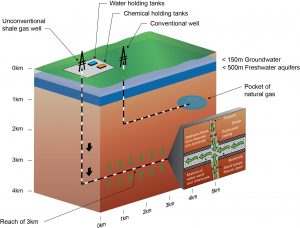
Natural gas produces less CO2 per unit of energy than coal and is therefore favoured as a transition fuel alongside carbon capture and storage and other low carbon forms of electricity generation including renewables and nuclear to assist in meeting carbon reduction targets. As a consequence, demand for natural gas is projected to increase as it delivers up to 45% of electricity generation in the UK in 2030. However, the UK has not been able to meet gas demand with native supplies since the turn of the century; in 2011 the UK imported more gas than it produced as demand for around 85 billion cubic meters a year continued.
In the United States, shale gas – extracted by hydraulic fracturing or ‘fracking’, a potentially water intensive practice – has revolutionised the energy market, reducing the wholesale price of natural gas and dramatically improving the country’s security of supply status. The UK government and gas sector are keen to emulate the success in the UK with exploratory wells already being drilled to determine shale prosperity and economic viability. While some see extracting shale as a means of securing the UK’s energy security well into the future, others are concerned that the water demand and emissions associated with extraction, together with a continued dependence on fossil fuels, possess the potential to cause adverse impacts to both the environment and public health. These risks are currently assessed and managed on a site-by-site basis yet it is felt that the development of the sector should be monitored cumulatively and that the shale gas sector could outpace research and its communication in the UK.
Jenna Brown (UWE), supervised by Dr Enda Hayes and Dr Chad Staddon, is reviewing the water demand of shale gas extraction and the emissions generated for her PhD. Shaped by the comments from a series of surveys and workshops, the water demand and locally generated emissions of potential shale gas developments will be displayed on a map using a geographic information system (GIS). The aim is to support the decision making process in planning applications and resource management by enhancing communication between key stakeholders including the gas sector, local councils, the water sector and the local community to maintain sustainable water supplies and air quality.
The project will be accompanied by a series of informative events by the team as the research develops, alongside working papers, articles and conference presentations.
